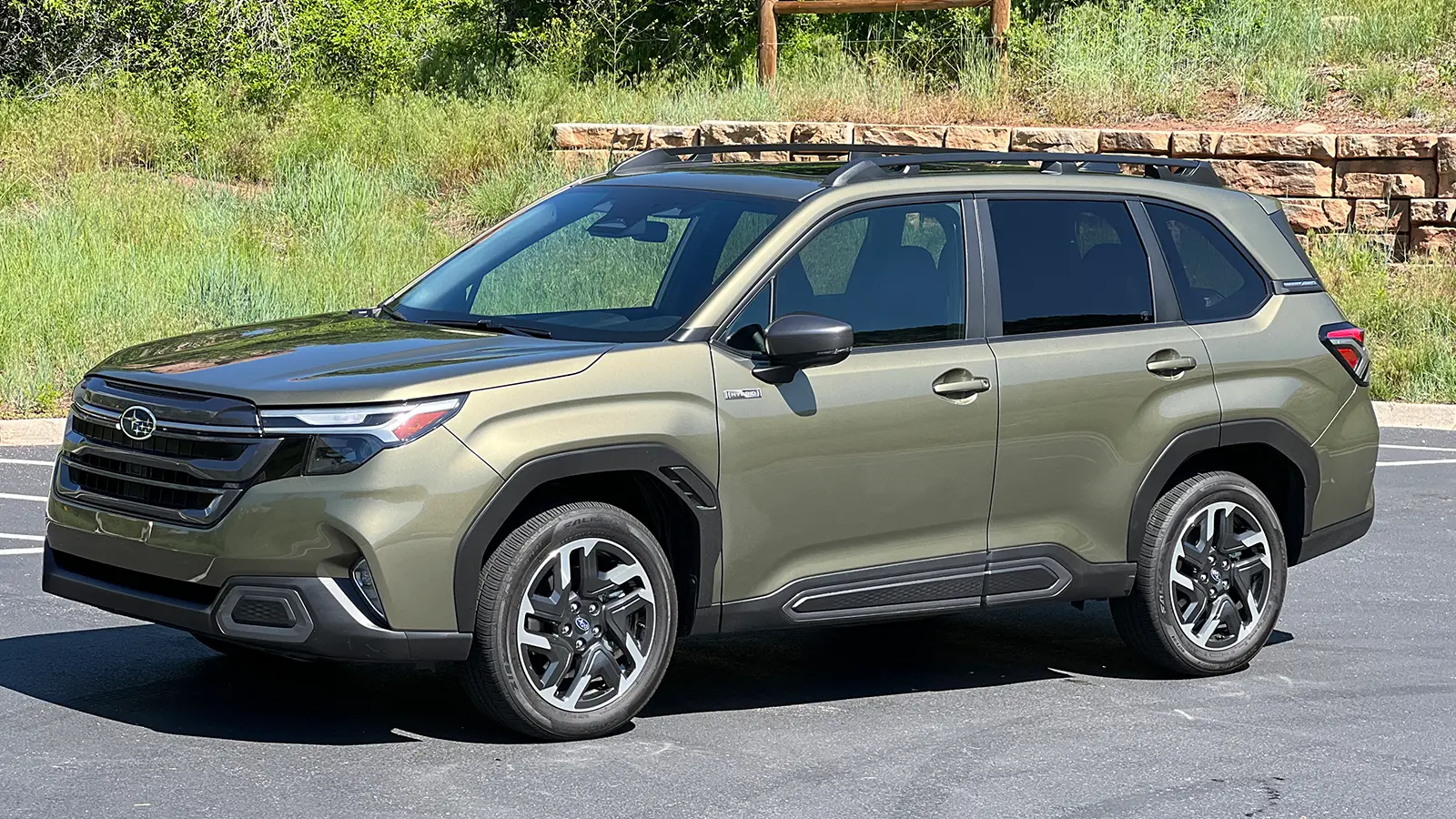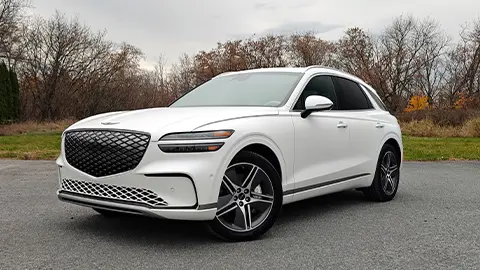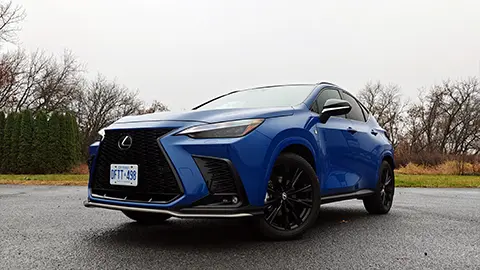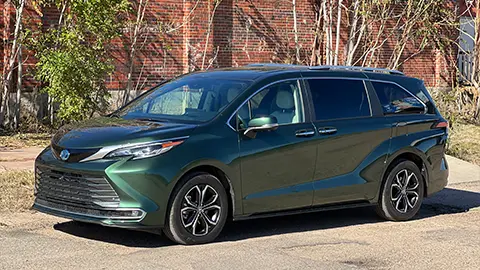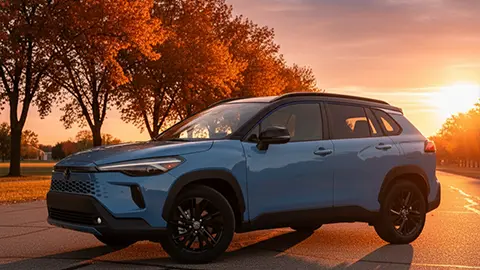⚡ Quick Takeaways Box
- Hybrid Efficiency: 35 mpg combined (EPA-estimated)
- Powertrain: 194 horsepower (gasoline-electric hybrid)
- Capability: Standard Subaru AWD with X-Mode off-road setting
- Space: 27.5 to 69.1 cubic feet of cargo capacity
- Pricing: Starts at $38,015; approximately $2,000 more than nonhybrid
Subaru has been a favorite of outdoorsy types for a generation or two thanks to its inherently capable all-wheel-drive crossovers. Yet while its Crosstrek, Outback, and Forester models have been able to get to a trailhead in confidence, they’ve always guzzled a fair amount of gas in the process.
That all changed for 2025 with the Forester Hybrid, the company’s first truly serious effort at a gasoline-electric powertrain.

Overview
To be fair, Subaru has been here before regarding hybrid powertrains. A decade ago, it offered a version of its Crosstrek with a hybrid powertrain, and it later followed up with a complex (and expensive) plug-in hybrid version. But neither offered an appealing value proposition in terms of fuel economy gains.
Enter the new Forester, which is a centerpiece of the Subaru lineup. Spacious, safe, and comfortable, it’s no wonder it's typically neck-and-neck with the automaker’s Outback as its bestselling model.
Wondering which electrified vehicle suits your lifestyle? Find your match here: EV Matchmaker
A 2025 model-year redesign brought fresh styling outside, a big vertical screen inside, and a host of refinement tweaks designed to make it ride, handle, and coddle better than ever.
The Forester Hybrid doesn’t alter any of those virtues. It does provide a big boost in fuel economy and a small kick in the bumper when it comes to acceleration.
The Forester Hybrid Builds on Subaru’s Flat-Four Engine
Nonhybrid Foresters use a 2.5-liter flat-four engine that serves as the starting point for the hybrid model. Subaru bolted up a 118-horsepower electric motor fed by a high-voltage lithium-ion battery pack located in the cargo area.
A continuously variable automatic transmission (CVT) routes power to all four wheels through mechanical differentials, which stands in marked contrast to the hybrid systems used in some rivals like the Toyota RAV4 Hybrid and Mazda CX-50 Hybrid. Those models have an electronic motor mounted at the rear axle rather than a conventional mechanical setup.
Subaru touts its system’s relative lack of complexity in its ability to keep prices low, but more on that in a moment.
The EPA’s test pegs the 2025 Forester Hybrid at 35 mpg city, 34 highway, 35 combined. Those figures easily best the 28 to 29 mpg combined for most nonhybrid trims, which works out to an estimated savings of $300 annually in fuel.
That said, the Forester Hybrid trails some competitors. The Toyota RAV4 Hybrid approaches 40 mpg, and fuel misers who don’t need all-wheel drive can see up to 43 mpg combined in the Kia Sportage Hybrid.
Otherwise, the Forester is pretty conventional for a crossover SUV. You’ll find a softly tuned, fully independent suspension and 18- or 19-inch alloy wheels depending on the trim level. There’s even an off-road drive mode that Subaru calls X-Mode. Don’t look for an especially capable version, though. At least for 2025, Subaru doesn’t pair its high-riding Wilderness trim level with the hybrid powertrain.
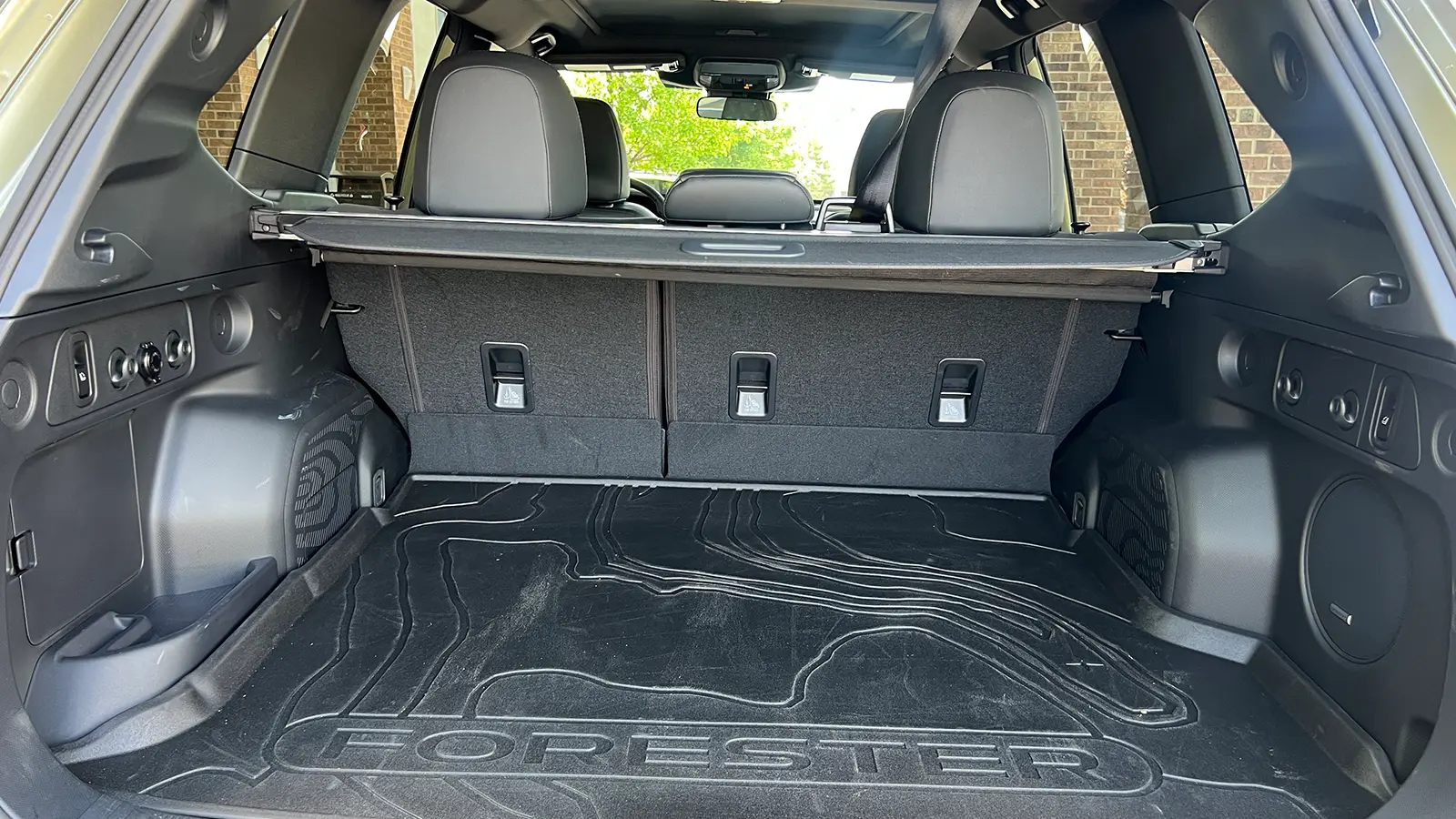
Plenty of Room
Subaru carved out a lot of space in its Forester Hybrid. The dash has a busy look, even though most controls are integrated into the touchscreen. Cloth upholstery comes standard, while higher-end versions swap in synthetic or real leather trim. Rear-seat riders have an impressive 39.4 inches of legroom.
Though the top-end Touring trim can top an MSRP of $44,000, no Forester Hybrid is all that dressy inside. Mazda’s CX-50 can feel snazzier when fully outfitted.
The Forester’s steering wheel frames a big 12.3-inch digital instrument cluster. A vertically oriented 11.6-inch touchscreen graces the center of the dash, and it’s fitted with standard wireless Apple CarPlay and Android Auto compatibility. Navigation and Harman Kardon speakers are available.
Ready to shop hybrids and EVs? Explore our complete guide: Buyer's Guide
Safety-wise, the Forester comes with Subaru’s EyeSight suite of crash-avoidance tech, including forward automatic emergency braking, active lane control, adaptive cruise control, and rear cross-traffic alerts. Reverse automatic emergency braking, a driver-attention monitor, and a surround-view camera system are available as you work your way up the four-trim lineup.
Forester Hybrid Can Tow, at Least a Little Bit
The Forester is among the most spacious in its class when it comes to cargo-hauling. Pop open the hands-free power liftgate and you’ll find 27.5 cubic feet of cargo space, which grows to as much as 69.1 cubic feet with the second-row seatbacks flopped down.
The Forester Hybrid can be equipped to tow up to 1,500 pounds.

What’s It Like To Drive?
The virtues that make the nonhybrid Forester appealing remain intact with the gasoline-electric version. It rides somewhat softly, even with the available 19-inch alloy wheels that wear tires with a rather short sidewall. Its steering is quick and evenly weighted, and it returns nicely to center as the driver exits a curve.
Combined, the gasoline-fueled engine and electric motor provide a total output of 194 horsepower. That’s a bit more than the regular Forester’s 180 horsepower, but the extra heft of all those hybrid bits means there’s no serious improvement in performance. Car and Driver magazine clocked one at 8.3 seconds to 60 mph, which is adequate but hardly thrilling. The Toyota RAV4 Hybrid, by comparison, does that deed in just 7.3 seconds. Instead of improving acceleration, the electric powertrain adds some extra oomph useful for highway passing.
What the Forester Hybrid does best is accelerate smoothly and quietly. Its refinement approaches and exceeds, in some cases, benchmarks set by some luxury brands. The gas engine is so quiet, for instance, that the automatic start-stop system hardly registers inside the cabin. The transition from gasoline to electric power is virtually unnoticeable.
Don’t look for more spirited performance from the Sport trim level; it’s about looks, not performance.
Forester Hybrid is $2,000 More Than a Nonhybrid Model
The Forester Hybrid comes in four trim levels: Premium, Sport, Limited, and Touring.
The base Premium trim kicks the lineup off with an MSRP of $38,015 including a mandatory $1,420 destination charge. It’s outfitted with 18-inch alloy wheels, a power panoramic sunroof, cloth seats with power adjustment for the driver, heated front seats, a 12.3-inch digital instrument cluster, and an 11.6-inch touchscreen with wireless Apple CarPlay and Android Auto compatibility.
For comparison, the nonhybrid Forester Premium costs a hefty $3,200 less, though the difference narrows to about $2,000 once you add the power liftgate and blind-spot monitors that come with the hybrid powertrain.
From there, the Sport trim adds synthetic leather upholstery, 19-inch alloy wheels, and Harman Kardon speakers for $41,015. At $42,430, the Forester Hybrid Limited has navigation, a power-adjustable passenger seat, and rain-sensing automatic windshield wipers.
The lineup culminates in the Forester Hybrid Touring with its leather seats, ventilated front seats, and surround-view camera system for $44,715.
Explore More 2025 Premium Hybrid & Electric Reviews
2025 Toyota Camry Hybrid Road Test
We tested Toyota’s iconic sedan in its hybrid-only form for 2025—see how it stacks up for efficiency, comfort, and driving enjoyment.
Read More ➜
2025 Mazda CX-50 Hybrid Review
Mazda’s CX-50 Hybrid offers premium style, excellent efficiency, and impressive performance. Dive into our full review here.
Read More ➜
2025 Lexus RX F Sport Review
Lexus combines luxury, sporty handling, and hybrid efficiency in its latest RX F Sport. Check out our detailed review and road test.
Read More ➜





